Breeds and Types of Lovebirds ( Most Popular)
Last Updated on November 7, 2023 by Ali Shahid
As one of the most colorful pet birds, lovebirds come in a wide variety of types throughout the world. It is a colorful and sociable parrot and is one of the most popular small birds kept as pets in the world. It is sometimes referred to as a pocket-sized parrot because of its size.
Are you considering getting a lovebird as a pet and wondering what types are available? There is no need to worry; I will provide you with detailed information about different types of lovebirds.
Agapornis and Psittaciformes are genera and orders of small parrots that consist of all types of lovebirds. It is estimated that there are nine species of lovebird, with eight coming from Africa and one from Madagascar.
Bird lovers will find these three species to be delightful and loving companions. They are not required to be paired up with lovebirds to be happy. As an avian vet, I always encourage my clients to keep any three of these species as pets.
There are six other species, all of which are considered rare and do not usually exist in captivity. This article covers the various species of lovebirds, their characteristics, the most common types of lovebirds found as pets, as well as the rarest ones.
1. Peach-faced lovebird or Agapornis roseicollis
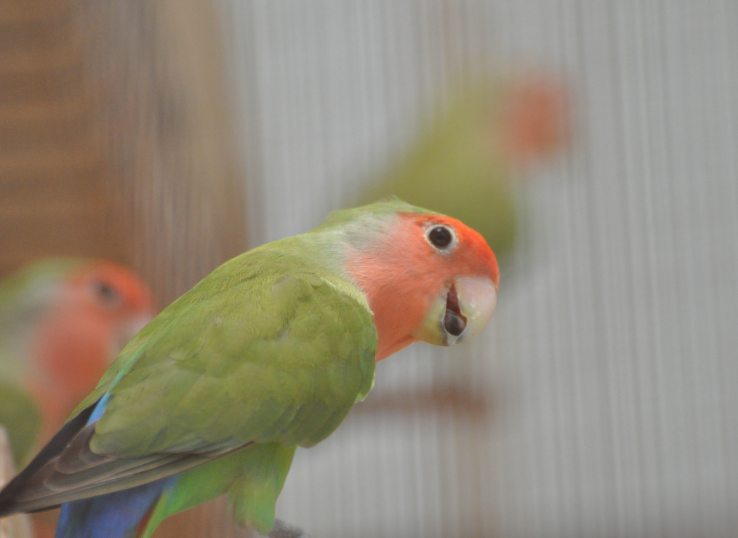
Specie Overview:
- Scientific Name: Agapornis roseicolli
- Length: 7 inches
- Weight: Under 2 Ounce
- Lifespan: 12 to 15 years
The lovebird is the most owned type as a pet. When we think of lovebirds, we imagine their beautiful plumage and cute faces. Although they are not difficult to maintain, they can also be a bit aggressive. When it comes to your first interactions with them, you should be careful.
This breed is alert, cheeky, and curious. Despite their size, they are excellent escape artists and enjoy playing with each other. These Lovebirds are social birds whose well-being is enhanced by interaction with a partner, be it a human or another Lovebird.
Size and Color Markings
This bird’s body is green, and its face and throat are peaches- or red. Its tail is blue. Neither its male nor female counterparts look different. When young, the face and throat of birds are pale pinks, and the body is greenish. These lovebirds have brown irises, a pale gray beak, and gray legs.
Peach-faced Lovebirds are quite small species that measure around 17-18 cm in length from head to tail. Each one measures 106mm in width and is about 55 grams in weight.
Diet and Habitat
They originated in Namibia and Angola, both in southern Africa. The outskirts of deserts, sparse woods, and mountain ranges are ideal locations for these birds. They are very hardy, but they need water to thrive.
Seeds, grains, nuts, and flowers make up the bulk of their diet. Because of their propensity to eat millet and other farm crops, they are frequently labeled as pests.
There is a wider price range for these birds, from $100 to $450.00 on average.
2. Nyasa or Lilian’s Lovebirds (Agapornis lilianae)
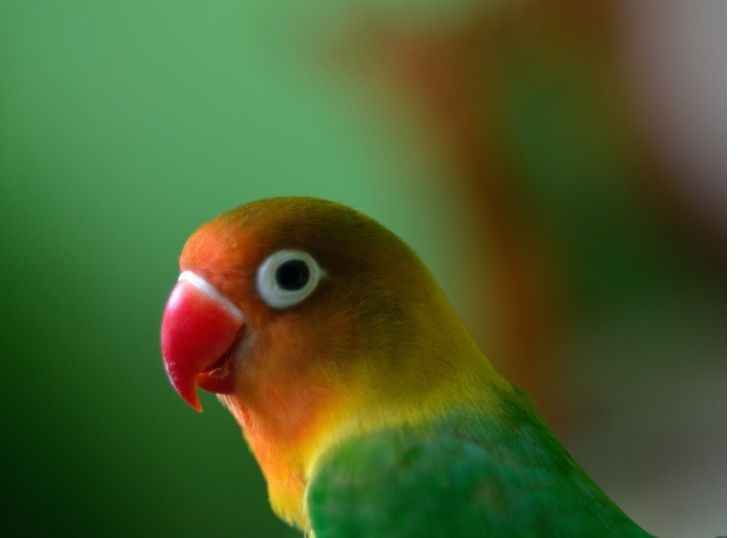
Specie Overview:
- Scientific Name: Agapornis lilianae
- Length: 5 inches
- Weight: 1.0-1.3 Ounce
- Lifespan: 10 to 12 years
Lilian’s Lovebird, commonly known as Nyasa Lovebird, is a tiny African lovebird species. It is mostly green, with orange highlights on its head and breast
Even though it is common in much of its habitat, it is thought that there are fewer than 20,000 of them. This makes them one of the most endangered species of lovebird. These Lovebirds are one of the most understudied species, partially due to their rarity.
Even though they are small, lovebirds are curious and bold by nature. Their playful and energetic nature makes them adept tree climbers. They exhibit affection and intelligence and can mimic others.
Size and Color Markings
Despite the white rings around its eyes, this lovebird’s primary color is green. The head, neck, and upper chest of this fish are covered in an orange pattern, which is complemented by green on the rump. Its external characteristics are identical in males and females.
There is a common mistake being made between Lilian’s lovebird and Fischer’s lovebird, which has a bluish rump and olive-green hood. Rosey-faced lovebirds are also similar; however, their orange coloration is more clearly defined, and they lack a white eye ring.
These birds’ orange beaks contrast with their black eyes and white eye rings. The average size of these birds is 1.3–1.4 ounces, and their height is 5.4 inches. These birds attract a lot of attention due to their loud chirping and continual chattering.
Diet and Habitat
The Lilian’s Lovebird is only found in Malawi, northern Mozambique, southern Tanzania, eastern Zambia, and eastern Zimbabwe. Its current range includes Liwonde National Park (LNP) and a small part of the forest outside the park.
Since its feeding and breeding sites are being used for agricultural purposes, this species’ range is quickly contracting, and it is now found only in Pakistan.
The diet of Lilian’s Lovebird consists mostly of grass seeds, such as Hyparrhenia, millet, wild rice, and flowers, as well as the seeds and fruit of other species.
Lillian lovebirds are priced between $100 and $400.
3. Black-Cheeked Lovebirds (Agapornis nigrigenis)
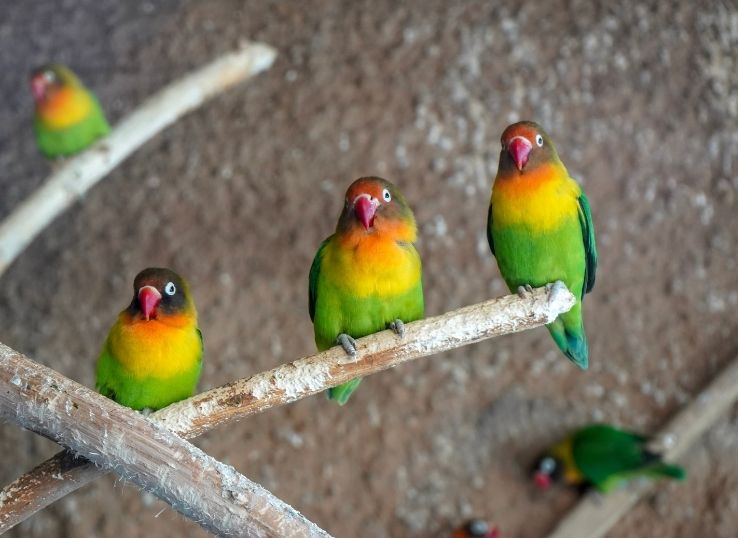
Specie Overview:
- Scientific Name: Agapornis nigrigenis
- Length: 5 to 5.5 inches
- Weight: 1 to 1.5 ounces
- Lifespan: 15 to 20 years
The Black-Cheeked Lovebird is a cute and tiny species of parrot native to Africa. Because of increasing habitat destruction and a small range, they are critically endangered.
The black-cheeked lovebirds have now been recognized as a distinct species rather than a subspecies of the Nyasa or Lilian’s lovebird.
This species inhabits a relatively small area in Zambia’s southwest. Lovebirds of this species tend to be quieter than those of other species. They like to take showers. Despite their snapping, they are energetic, tough, friendly, and agile.
They typically do not talk like some other types of parrots. Nonetheless, they still make a lot of noise and want constant attention. These beloved pets, which are often kept in pairs, may be highly territorial when kept with other birds in a large cage or aviary.
If you want to keep them well-mannered and submissive, you should play with them daily. These birds, like any others, may learn to do tricks if given the proper care and attention. Being gentle by nature, they may experience stress in crowded conditions.
Despite their pleasant appearance, they can be a nuisance because of their harsh, high-pitched noise.
Size and Color Markings
The upper parts of these birds, especially the wings, are clothed in dark green plumage, while the underparts are coated in a lighter green.
A light brown color transitions to an orange color on the chest. Their eyes have white rings surrounding them, and their heads and beaks are dark brown. Their crimson beaks are easy to spot.
Typically, adults measure 13 to 14 centimeters (five to five and a half inches) long (including the tail) and weigh between 40 and 45 grams (about 1.4 ounces).
Diet and Habitat
Black-cheeked lovebirds inhabit deciduous forests, where there is permanent surface water as long as they have access to it every day. Birds migrate in flocks of up to 800 when the dry season arrives. There may be populations in Zimbabwe and Botswana as well as Zambia.
The black-cheeked lovebird eats insect larvae, corn, sorghum, and millet. It also eats annual grass seeds and plant matter.
Black-cheeked lovebirds can cost anywhere from $200 to $500. The loss of its natural habitat has led the IUCN to list this species as “vulnerable” on its Red List of endangered species.
4. Madagascar or Grey-Headed Lovebirds (Agapornis cana)

Specie Overview:
- Scientific Name: Agapornis cana
- Length: 5 to 5.5 inches
- Weight: 1– 1.3 oz
- Lifespan: 10-20 years
A playful, curious, and somewhat aggressive bird, the Grey-Headed Lovebird can be quite bouncy. It has a big personality despite its small stature.
Even while being hand-fed, they still have an anxious disposition and are easily scared in an aviary. Their reserved nature makes them poor pet choices. They are not being held in captivity at the moment.
Since Madagascar Lovebirds are not prolific breeders and are difficult to rear, they are extremely rare outside of Madagascar
Size and Color Marking
The Madagascar Lovebird is the smallest of all lovebird species, measuring between 5 and 5.5 inches in length and weighing between 1 and 1.3 ounces. This species of lovebird has different color patterns for males and females.
As for the females, they are entirely covered in green plumage, although their wings and backs are darker. Sometimes, it is paler on their chest. Males have a pale gray color, almost appearing off-white.
Diet and Habitat
They are originally from the African island of Madagascar. They also populate the nearby islands, but only in small numbers. There have been a few reports of sightings on the continent of South Africa.
The grey-headed lovebirds’ natural diet consists primarily of various grass seeds. One of the most popular foods is rice, which is grown in Madagascar and makes a delicious and romantic snack. It is extremely difficult to find Madagascar lovebirds for sale.
Grey-headed-lovebird has not yet been assessed for its population status. Although experts believe that there is no threat to them, they certainly have a population of over 10,000.
Most pet stores sell Grey-Headed Lovebirds at a cost of $40 to $200.
5. Black-Collared or Swindern’s Lovebird

Specie Overview
- Scientific Name: Agapornis swinderniana
- Length: 4–5 inches
- Weight: 1.5 – 1.8 oz
- Lifespan: 10-20 years
The black-collared lovebird is a rare lovebird species discovered by Heinrich Kuhl in 1820. It is also known as Swindern’s Lovebird (Agapornis swinderniana).
This species of lovebird is also scarce. These lovebirds cannot survive in captivity because of their diet preference for native figs. In addition to being somewhat shy of all living creatures, they are commonly seen in trees at very high altitudes.
Size and Color Marking
Lovebirds with black collars are primarily green, but they can also exhibit blue, yellow, brown, and red plumage under their green upper plumage. These birds look like black-masked lovebirds, except they lack black masks on their faces. The collar around their neck is black.
The length of this species is roughly 5 inches (head to tail), and its weight is about 1.5–1.8 ounces, making it about average for lovebirds
Diet and Habitat
Black-collared lovebirds can be found throughout equatorial Africa. In particular, they occur in Cameroon, Congo, Equatorial Guinea, Gabon, Ghana, Liberia, Uganda, and the Central African Republic.
It is quite hard to give a black-collared lovebird its essential daily diet of native fig seed or fig flesh outside of its natural environment. Without these figs, they will not be able to survive or reproduce in captivity, and many will perish quickly.
The Black-Collared Lovebird cannot breed, thrive, or even survive without their native figs, so it is not kept as a pet.
6. Black-Winged or Abyssinian Lovebird

Specie Overview:
- Scientific Name: Agapornis taranta
- Length: 6-7 inches
- Weight: 1.7 ounces
- Lifespan: 15-30 years
The African Black-winged Lovebird is found in the mountainous regions of southern Eritrea and Ethiopia, between 1,800 and 3,200 meters.
It is also known as the Abyssinian Lovebird; the Black-winged Lovebird has been breeding in captivity for only a short time.
The breed is one of the tiniest parrot species while also being one of the largest lovebird varieties currently in existence. In the wild, these birds prefer to reside at altitudes of up to 10,000 feet above sea level.
They also prefer to reside in small groups of up to 20 individuals. This is also the only species of lovebird to line its nests with feathers. Because of their need for companionship, black-winged lovebirds are unhappy when kept alone.
Throughout the day, these birds spend a significant amount of time preening on one another.
Yet, these lovebirds are known to get violent when sharing confined spaces with other lovebirds. Therefore, they require a large environment to ensure a peaceful and happy existence.
Size and Color Marking
The lovebird is a dimorphic species, which means that both the male and the female are different. Male birds have red foreheads, while females have green ones. Nonetheless, both sexes have green plumage.
Typically, they are larger than other lovebird species, weighing around 48g on average and standing 6 – 7 inches tall. Typically, males have green plumage characterized by black underwings and a red forehead, whereas females usually have green plumage all over without any noticeable characteristics.
Diet and Habitat
Black-winged lovebirds are native to the high plains and hilly areas of southern Eritrea and southwest Ethiopia. The Black-Winged Lovebird’s diet depends on where it lives, but it usually includes grass seeds, leaves, and different bugs and worms.
As a result of their scarcity in zoos and pet stores, black-winged lovebirds are expensive. There’s a price range of $200–500 for the birds with black wings.
7. Fischer’s Lovebird (Agapornis Fischeri)
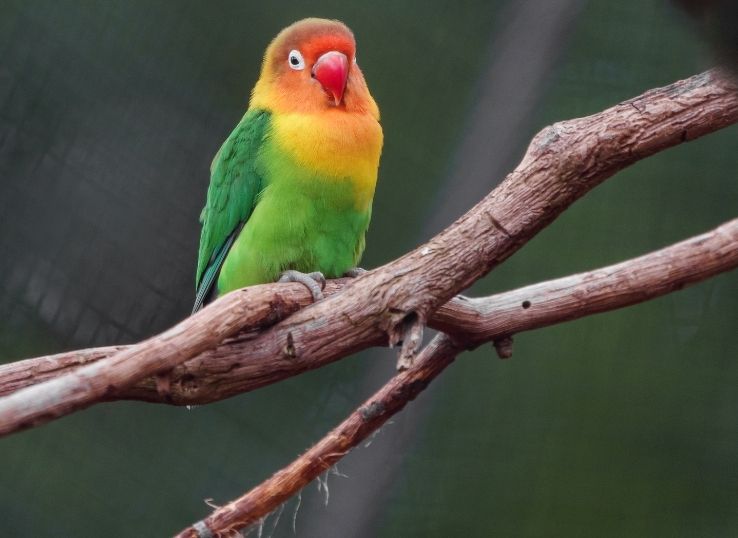
Specie Overview:
- Scientific Name: Agapornis Fischeri
- Length: 6 inches
- Weight: 2 ounces
- Lifespan: 15-20 years
Fisher’s Lovebirds are known for their playful and social natures and are found throughout the world.
If you talk to the Fischers lovebird often, it might turn out to be a reliable and lively friend. Fischer’s lovebirds are lively but more placid than other species of lovebirds, especially when housed in an aviary.
The Fischer’s lovebird isn’t as well-known as the more widespread peach-faced lovebird, but its demeanor is just as endearing. While being less well-known than its peach-faced counterpart, Fischers are far from boring.
It breeds quickly in captivity, so you can find domesticated offspring at practically any pet store. Lovebird enthusiasts typically pay significantly more for rare mutations than for the standard peach-faced lovebird.
Size and Color Markings
These lovebirds are tiny, measuring about 5 to 6 inches from beak to tail and weighing around 1.5 to 2 ounces at most. Some variations in coloration can be seen on Fischer’s Lovebird’s breast, wings, and back, but its overall appearance is a vivid green-blue.
This gradually becomes a golden yellow around the neck and an orangey-brown on the crowns of their heads. They have white eye rings and dark orange beaks.
Diet and Habitat
The unique Fischer’s lovebird lives in the grasslands, savannas, and scrub woodlands of north-central Tanzania. They might also settle in rural regions close to agricultural centers.
Larger groups of a hundred or more birds choose agricultural regions among millet and maize crops. However, smaller flocks of ten to fifteen birds prefer grassland areas with acacias and baobab trees.
Seeds and fruit, especially fallen berries and fruits, make up the bulk of Fischer’s lovebirds’ diet.
Farmers consider them pests since flocks of them can number in the hundreds and sometimes damage maturing agricultural crops (maize and millet). Water is also a daily necessity for the birds.
Prices for Fisher’s Lovebirds can be anywhere from $100 to $350.
8. Red-Faced Lovebirds (Agapornis pullaria)

Specie Overview:
- Scientific Name: Agapornis pullarius
- Length: 6 inches
- Weight: 1.5 ounce
- Lifespan: 15 years
Red-faced Lovebirds are attractive birds with beautiful appearances. To breed them in captivity, many attempts have been made, but all of them have failed. Nesting, companionship, and diet are specific requirements that can only be met in the native environment.
They have been seen hanging upside down from trees, like bats, to roost or preen each other. Some captive birds are said to sleep in an inverted position. Because of their shy nature, they are rarely kept as pets.
It’s possible that the Red-faced Lovebird was the first species of lovebird brought to Europe. There is evidence that it was already being used in 16th-century portraits, according to the Duke of Bedford.
Size and Color Marking
Birds in this species are mostly green. The bird has a clearly defined red area around the top of the beak, extending across the forehead and down to the mid-crown, as well as extending on the sides up to the eyelid margins. Its feet are grey.
When fully grown, they attain a length of around 6 inches and a weight of about 1.5 ounces.
Both wings have a lighter green underside. Orange is the color of the female’s head, which is less distinct than red on the male. In adult males, the beak is red, but in females, the beak is paler.
Diet and Habitat
There seems to be no lovebird with a larger territory than the Red-faced Lovebird, also known as the Red-headed Lovebird. There are many tropical rainforests along the equator of Africa where they can be found. Angola, Uganda, Sierra Leone, and Liberia are some of the countries where they appear.
Red-faced lovebirds have a very extensive range, making it hard to estimate their population size, but they do not appear to be under threat.
They inhabit open areas such as arable land, rainforests, and lowland savannas. They travel great distances during the day in search of food, which often consists of grass seeds, various fruits, and occasionally planted crops.
It may be challenging to locate a breeder or store that offers birds obtained in a morally acceptable manner, as these birds are notoriously hard to breed in captivity.
9. Black-Masked or Yellow-collared Lovebirds (Agapornis personata)
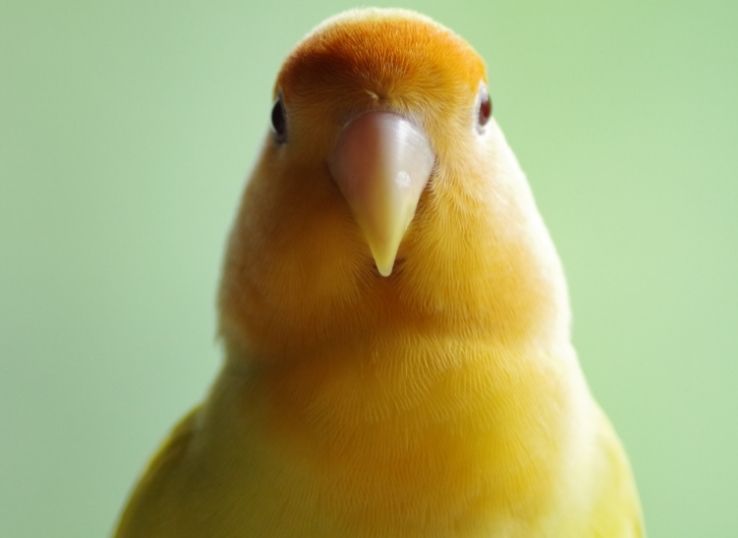
Specie Overview:
- Scientific Name: Agapornis personata
- Length: 5.5 inches
- Weight: 1.5-1.7 ounce
- Lifespan: 10 to 15 years
The yellow-collared lovebird is one of the best-known species in the family of lovebirds. They enjoy each other’s company tremendously, and the pair is happy together. When it comes to personality, it shares traits with other species of lovebirds.
Their high levels of enthusiasm are well known. Despite their high activity level, their small stature makes them more manageable as pets.
They’re adorable, and they get along with all kinds of people. Ensure that there is enough space for the birds to avoid fighting when housing a large number of birds together.
They can fly well, but their favorite activity is entering their cage. During the breeding season, females are more aggressive and heavier than males, making the latter a better option as a pet.
Size and Color Marking
In this species, males tend to be a bit bigger than females. Yet, the birds won’t exceed 1.7 ounces in weight, and they seldom exceed 5.5 inches in length, making them even smaller than Rosy-Faced Lovebirds.
These birds have a black mask-like crown that extends down over their eyes and beak. The white rings around their dark brown or black eyes emphasize the mask quality. Their crimson beaks are equally eye-catching.
There is a brilliant yellow collar that spans the length of their bodies, gradually fading to a green hue. Blue highlights occasionally appear on their tails and wings. Its legs and feet have a grayish color.
Diet and Habitat
The majority of the masked lovebird’s natural range is in northeast Tanzania. But it has also been exported to other regions, including Burundi and Kenya. This species has successfully bred in these places and may now be regarded as “established” there.
They have been spotted in Puerto Rico’s wilds. They, however, are most likely the consequence of stray or lost pets. These birds eat a variety of foods in the wild, including fruit, grass, seeds, and vegetables.
Everything they can get their mouths on is fair game for them. Their diet often varies with both their geographical region and the season.
They typically weigh between 43 and 50 grams. The black-masked lovebirds range from $35 and $100 and are readily available worldwide.
Common Characteristics of Lovebird
A long, blunt tail, a thin body, and a sharp beak are their physical characteristics. They can usually be recognized by their colors. Other similarities among all Lovebirds include their zygodactyl feet.
These small birds hold onto small items and maintain their balance while perching with two toes facing forward and two toes facing backward. Lovebirds are all one size, which is one of their most defining characteristics.
It is because of the small size of these parrots, which are generally less than five inches tall. That is why they are commonly known as pocket parrots.
Common Lovebird Species:
- Peach-face Lovebirds
- Black Masked Lovebirds
- Fischer’s Lovebirds
Rare Lovebird Species:
- Lilian’s Lovebirds aka Nyasa Lovebirds
- Abyssinian Lovebirds
- Black-cheeked Lovebirds
- Black-collared Lovebirds
- Madagascar Lovebirds or Grey-headed Lovebirds
- Red-faced Lovebirds
Common Lovebird Species:
- Peachface Lovebirds (Agapornis roseicollis)
- Black Masked or Masked Lovebirds (Agapornis personata)
- Fischers Lovebirds (Agapornis fischeri)
Dimorphic Lovebird Species
Males and females can be distinguished visually.
- Abyssinian Lovebirds
The male is characterized by a red forehead, lores, and a small ring of feathers surrounding the eye. Females do not have red markings on their heads or around their eyes.
- Madagascar Lovebirds or Grey-headed Lovebirds
In the male, the head, back of the neck, and breasts are gray in color. Other than that, he has a green appearance. The female is entirely green in color.
- Red-faced Lovebirds
A bright orange-red color is present on the face of the male. The underwing coverts (feathers) of the male are black. The female’s face is orange rather than as brightly red as the male’s. She has green underwing coverts (feathers).
Monomorphic Lovebird Species
These series have lovebird species in which males and females are identical. They are further divided into:
- Eye-Rings (white featherless bare skin area around the eyes)
- Non-Eye Rings (Not have eye rings)
Eye-Rings
- Masked Love Bird
- Fischer’s Lovebird
- Nyasa Lovebird or Lilian’s Lovebird
- Black-cheeked Lovebird
Non-Eye Rings
- Peach-faced Lovebird
- Black-collared Lovebird or Swindern’s Lovebird
Frequently Asked Questions
Which is the biggest lovebird?
This black-winged lovebird, the largest of all the lovebird species, can grow to a length of 16–16.5 cm (6.25–6.5 inches).
Is it easy to breed lovebirds?
A breeding lovebird is a rewarding, educational, and challenging hobby that is simple to get started with. If they are a true and mature pair (at least 10 months old), they will breed fairly quickly.
What is the smallest lovebird?
Lovebirds, or lovebird genus species, such as Lilian’s lovebird, are the smallest African parrots similar to the Nyasa lovebird. The smallest parrot in mainland Africa measures 13 cm (5 inches).
How many types of love birds are there?
At present, nine species of lovebirds have been discovered worldwide. Some of these species do not make good pets.
What is the rarest type of lovebird?
Among the different species of lovebirds, the Nyasa lovebird holds the distinction of being the rarest. It is a seldom seen bird in captivity, primarily because of the difficulties associated with their breeding. This relative scarcity in captivity means that there is less information available about the Nyasa lovebird compared to other more common lovebird species.
Which type of love bird is best?
Peach-faced lovebirds, scientifically known as Agapornis roseicollis, stand out as the best, largest, and most commonly kept lovebirds. Originating from Africa, these small and vibrantly colored parrots have become a popular choice among avian enthusiasts. They are known for their remarkable inquisitiveness, playful nature, and delightful, spirited sassiness that adds to their charm.
Conclusion
There may be many subspecies of lovebirds to choose from, but each one of them has a different practical reality. Therefore, it is always best to learn a little bit about the breed and type of lovebird before getting one.

